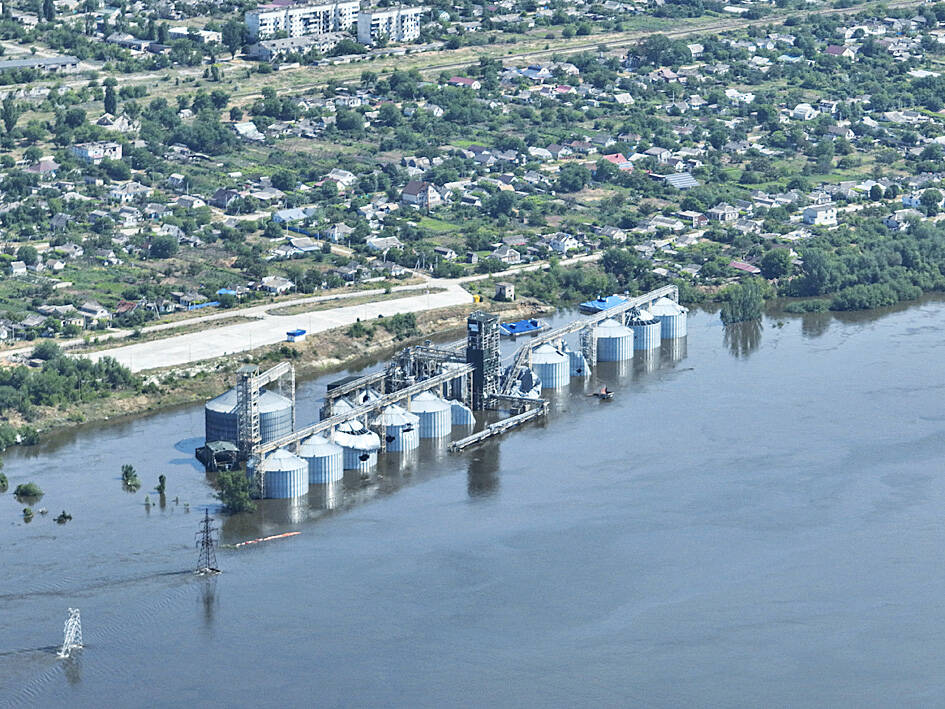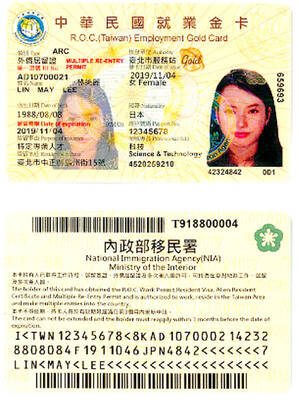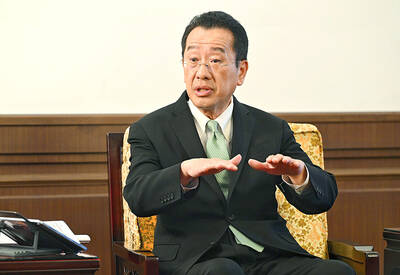Thousands fled their homes on Wednesday after the destruction of a Russian-held dam in Ukraine flooded dozens of villages and parts of a nearby city, sparking fears of a humanitarian disaster.
Ukraine and Russia have traded blame for the destruction of the Kakhovka dam on Tuesday.
The breach of the dam in southern Ukraine, which provides cooling water for Europe’s largest nuclear plant, took place as Ukrainian troops prepared to launch an offensive to recover lost territory.

Photo: AP
Downstream from the breached Kakhovka dam, police and troops in Kherson were taking people out from inundated areas in inflatable boats, most clutching only a few documents or pets.
Despite the evacuations, Ukrainian officials said that Russian forces kept shelling the residential neighborhoods.
“We no longer have a home,” said Dmitry Melnikov, 46, who was evacuated with his five children.
“We have been here since the beginning of the war, we survived the occupation,” said Melnikov, whose family was being evacuated to the southern city of Mykolaiv.
“But now we have no home, no nothing, no work. We don’t want to leave, but what can we do?” he added.
As the mutual recriminations continued, Moscow accused Kyiv of blowing up a section of the Togliatti-Odesa pipeline.
Russia used it before the war to export ammonia, and its reactivation had been requested as part of talks for a deal on Ukraine grain exports.
Turkish President Recep Tayyip Erdogan proposed an international commission to investigate the damage after speaking with Russian President Vladimir Putin and Ukrainian President Volodymyr Zelenskiy.
Zelenskiy wrote on Twitter that he had sent Erdogan “a list of Ukraine’s urgent needs to eliminate the disaster.”
Putin denounced the breach as “a barbaric act which has led to a large-scale environmental and humanitarian catastrophe,” the Kremlin said.
British Secretary of State for Foreign and Commonwealth Affairs James Cleverly on Wednesday said that London was unwilling to apportion blame yet, as it was waiting for “all available facts.”
However, Russia bears ultimate responsibility, as “this event is a direct repercussion of Russia’s invasion of Ukraine,” he said.
Almost 6,000 people have been evacuated from the flooded regions, statements from Russian and Ukrainian officials said — about 4,000 people on the Russian side and nearly 2,000 on the Ukraine side.

GAINING STEAM: The scheme initially failed to gather much attention, with only 188 cards issued in its first year, but gained popularity amid the COVID-19 pandemic Applications for the Employment Gold Card have increased in the past few years, with the card having been issued to a total of 13,191 people from 101 countries since its introduction in 2018, the National Development Council (NDC) said yesterday. Those who have received the card have included celebrities, such as former NBA star Dwight Howard and Australian-South Korean cheerleader Dahye Lee, the NDC said. The four-in-one Employment Gold Card combines a work permit, resident visa, Alien Resident Certificate (ARC) and re-entry permit. It was first introduced in February 2018 through the Act Governing Recruitment and Employment of Foreign Professionals (外國專業人才延攬及雇用法),

RESILIENCE: Deepening bilateral cooperation would extend the peace sustained over the 45 years since the Taiwan Relations Act, Greene said Taiwan-US relations are built on deep economic ties and shared values, American Institute in Taiwan (AIT) Director Raymond Greene said yesterday, adding that strengthening supply chain security in critical industries, enhancing societal resilience through cooperation and deepening partnerships are key to ensuring peace and stability for Taiwan in the years ahead. Greene made the remarks at the National Security Youth Forum, organized by National Taiwan University’s National Security and Strategy Studies Institution in Taipei. In his address in Mandarin Chinese, Greene said the Taiwan-US relationship is built on deep economic ties and shared interests, and grows stronger through the enduring friendship between

CAUTION URGED: Xiaohongshu and Douyin — the Chinese version of TikTok — are tools the Chinese government uses for its ‘united front’ propaganda, the MAC said Mainland Affairs Council (MAC) Minister Chiu Chui-cheng (邱垂正) yesterday urged people who use Chinese social media platforms to be cautious of being influenced by Beijing’s “united front” propaganda and undermining Taiwan’s sovereignty. Chiu made the remarks in response to queries about Chinese academic Zhang Weiwei (張維為) saying that as young Taiwanese are fond of interacting on Chinese app Xiaohongshu (小紅書, known as RedNote in English), “after unification with China, it would be easier to govern Taiwan than Hong Kong.” Zhang is professor of international relations at Shanghai’s Fudan University and director of its China Institute. When giving a speech at China’s Wuhan

ENHANCE DETERRENCE: Taiwan has to display ‘fierce resolve’ to defend itself for China to understand that the costs of war outweigh potential gains, Koo said Taiwan’s armed forces must reach a high level of combat readiness by 2027 to effectively deter a potential Chinese invasion, Minister of National Defense Wellington Koo (顧立雄) said in an interview with the Chinese-language Liberty Times (sister newspaper of the Taipei Times) published yesterday. His comments came three days after US Secretary of State Marco Rubio told the US Senate that deterring a Chinese attack on Taiwan requires making a conflict “cost more than what it’s worth.” Rubio made the remarks in response to a question about US policy on Taiwan’s defense from Republican Senator John Cornyn, who said that Chinese